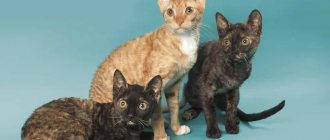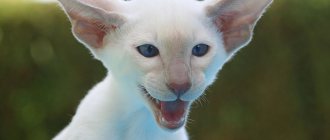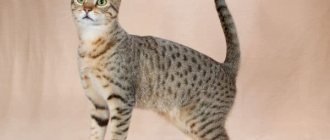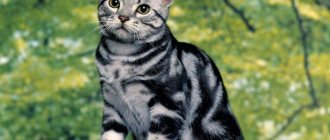How did the Kurilian Bobtail originate?
The breed appeared in the Far East, back in the days when this territory was quite isolated from external influence. The breed originated in the 19th century (at this time the first appearance of bobtails in human sight was recorded). The cats lived in prides and had no contact with humans. Local Kurilians began domesticating the breed, thanks to which Kurilian bobtails can now become pets of breeders around the world.
This is an aboriginal breed, and it originated in our country. Bobtails are completely natural in their habits.
They appeared on mainland lands only in the 50s; through selection, the breed was fixed at the genetic level, so it retains its characteristics to this day. Military geologists declared the existence of the Kuril Bobtail as an independent breed, but not everyone agreed that the Russian Bobtails are not descendants of the Japanese. The breed was noticed two centuries ago, but was recognized only in the 90s of the twentieth century.
Fluffy and fighting: stories of fighting cats
Fighting cats will not disappear anywhere. Even in the armed forces - in battles and wars. Everywhere they perform their military duty to the best of their ability. Today we will talk about the most famous ones.
Fighting cats in the Navy
The Egyptians, the first people to domesticate cats, took them with them on trips along the Nile, where the mustachioed cats caught birds.
Sailors from other countries adopted this tradition, and for many millennia cats have been guarding ship provisions.
And of course, they bring comfort and tranquility to the harsh everyday life at sea - where would we be without it? After all, even the most seasoned fighting cat, covered with scars, radiates a dose of cuteness.
One of the most famous tailed sailors is Oscar, nicknamed the Unsinkable Sam. He began his naval career on the German battleship Bismarck.
In connection with the superdreadnought's attempt to retrain as a submarine, he refused to continue serving the Germans (May 27, 1941).
The cat, who spent several hours on the wreckage of the steel giant on the open sea, was picked up by the English destroyer Cossack, and since then the pet has gone over to the side of the Allies. From them he received a new name - Oscar. So, according to the International Code of Signals, this is the name of the flag indicating a man overboard.
Six months later, the destroyer on which our hero served as a cat was attacked by a German submarine, received heavy damage and subsequently sank. Oscar and the sailors moved to another British destroyer. After which he received the nickname Unsinkable Sam.
After spending some time on land, Unsinkable Sam was recruited to the USS Ark Royal.
Apparently, the Germans, especially submariners, really valued the animal. And for the second time, on November 13, 1941, they turned to the British: “Bring back the cat!”
The British rejected the request (and rest assured, the fighting cat just as resolutely refused to return to the Nazis). The consequences were tragic - the aircraft carrier was sunk. But Oscar already had extensive experience of surviving in such conditions and remained unharmed. It was decided not to tempt fate, and after rescue our hero continued his service on land.
The story of Oscar the cat may be a myth. Perhaps he was not there at all. Or maybe there were several cats, and each time different tailed sailors were rescued. Nevertheless, the events described in themselves are quite probable, and English history buffs are still seriously delving into this topic, discussing it, and requesting information from newspaper archives.
Fighting cats in the Air Force
In 1910, people decided to cross the Atlantic Ocean for the first time by air - with the help of the airship America and the cat Kiddo, which they took on board.
The crew apparently assumed that the animal would become the mascot of the expedition, but Kiddo was not satisfied with such a passive role. The fighting cat decided to bring real benefits - and became a meteorologist.
Possessing a very sensitive hearing aid that responds to the slightest changes in pressure and even air humidity, cats have the necessary “qualifications” from birth.
At first, people and the furry weather forecaster had problems with communication.
Kiddo, conscientiously fulfilling her duties, calibrated her meteorological settings and signaled a drop in pressure, and for some reason the balloonists perceived this as an unreasonable yelling and rage.
But thanks to this, cats once again made history.
The first radio message from a flying object was dedicated specifically to Kiddo: “Roy, come and get this - damn cat.”
Subsequently, the team found a common language with the meowing crew member and noted that Kiddo works better than any barometer. Of course, it’s better—what doubts could there be!
Unfortunately, despite Kiddo's help, the people were unable to reach their destination. Nevertheless, there were some small victories: the cat and its crew covered a record 1,300 miles by air at that time.
Fighting cats in the Ministry of Emergency Situations
This story took place in November 1421. The Netherlands is hit by major flooding. Many coastal towns and villages were damaged. About ten thousand people died.
At that moment, when the water receded and people began to return to rebuild their homes, help the wounded, and so on, a baby’s cradle was noticed near the dam. The cat was running around the bed. People thought that the cradle was empty, but they decided to save the animal.
They were surprised to find a sleeping child there!
It turned out that the tailed rescuer, jumping from edge to edge, maintained its balance, preventing the cradle from turning over.
This story is most likely an urban legend. In the fabulous folklore of the Netherlands, there are episodes where a cat saves a baby in a crib that was carried away during a flood. So, in one fairy tale, a flood led a cradle with a girl and a cat to the island where her future groom lived.
However, such motives are not born out of nowhere. Surely a similar event took place in Dutch history. Therefore, we can safely assume that the cats were engaged in rescue at sea! At least ourselves...
Fighting cats in the Airborne Forces
Why are Airborne Forces needed? Throw soldiers behind enemy lines or to places that cannot be reached in any other way. This is what happened in Malaysia in 1960. In a place surrounded by jungle, fighters were urgently needed to fight rats and other pests.
The colonial government said: “We must!” - the cats said: “Yes!”
Several dozen tailed paratroopers were dropped with parachutes in the right place. The village and its surroundings were saved from the gray occupiers!
In RuNet, this story dates back to the 80s of the 20th century. They describe the small parachutes of each furry paratrooper. This is so cute! The authors probably see it something like this:
But everything was somewhat different. And not in the 80s, but in 1960.
Singapore "The Straits Times" dated March 17, 1960
For some reason, in a remote village in the jungle of Malaysia, all the cats have become extinct. Perhaps due to the use of pesticides (DDT, etc.). The local government decided to help the villagers and sent them reinforcements in the form of a platoon of landing cats and cats (23 soldiers). Due to the characteristics of the terrain and, apparently, for the sake of economy, they decided to use aviation.
Features of the breed.
The Kurilian Bobtail has a short tail. It should be noted that it is like this by nature, it is not docked or circumcised.
Felinologists became interested in these cats when they were already living with people and catching not only mice, but also fish. The Kurilian Bobtail is the most intelligent of its brothers. Many people seriously say that he is closer to a dog in his characteristics.
Kuril cats appeared and developed on the islands, so they are not afraid of water. They enjoy fishing and swimming.
Representatives of this breed are highly trainable (like dogs). With regular training, the cat can be taught commands such as “sit”, “place”, “no” and so on. Experienced breeders say that the Kurilian bobtail is capable of understanding about one and a half thousand words and phrases. If you pay attention to raising a smoker from an early age, he will never tear up wallpaper, spoil furniture or play dirty tricks. The Kuril Islands, in principle, do not show vindictiveness or aggression. They are not vindictive, even if they have been punished by their owner. A very intelligent and non-conflicting pet, he gets along easily with other animals (even dogs) and is safe for children. He is especially sociable and friendly with animals of his own breed.
Kurilian Bobtails treat their offspring very carefully. Not only females, but also males look after the kittens. If a mother cat is unable for some reason to care for her offspring, then someone from a large pride of cats will take over her responsibilities. However, if the cat is alone in the house, she will not leave the kittens until she teaches them to hunt and other skills necessary for life. An adult pet will even teach how to use a litter tray and other amenities.
When breeding Kuril Bobtails, you need to take into account the fact that they have matriarchy. You shouldn’t be surprised if it’s the cat who plays the main role in the house, not the tomcat.
It is also very important to know that bobtails make more than just the usual “meow” sounds. Their range is much wider than that of a normal cat. They can produce sounds similar to bleats, squeaks and pigeon coos.
A cat of this breed MUST be brushed periodically with special brushes, since historically the breed was formed in the wild and has a thick undercoat. This is especially important for long-haired animals.
The Kurilian Bobtail is not afraid of water, bathing is of interest to them, BUT washing the cat still does not give pleasure, so you need to teach it to wash from an early age.
These animals lead an active lifestyle, know how and love to jump high and hunt. At home, you need to provide smokers with favorable conditions: various scratching posts, shelves, toys. It is desirable that the storage room be spacious (ideally a private house). Your pet can be walked on a leash designed for small breed dogs.
The diet for such a cat should be balanced. Lack of minerals and nutrients in the diet can lead to digestive disorders.
When choosing a Kurilian Bobtail as a pet, you should pay attention to its pedigree, because animals with admixture may be genetically different and may not exhibit the special qualities of the unique breed.
jungle cat
The jungle cat is comparable in size to a medium-sized dog. If such an animal shows aggression and attacks, it will not seem like much even to an adult. Representatives of this breed are wild because they live in natural conditions. They have large, strong and very sharp teeth and claws, thanks to which they defend themselves or attack prey.
Many people keep such pets at home as exotic animals. Experiments were even conducted on crossing Siamese and jungle cats, resulting in predators with excellent fighting qualities.
TOP 10 breeds prone to aggressive behavior
Among domestic cats, the leaders in wayward behavior are oriental breeds. Although some Europeans are included in this list of TOP 10 most wayward. It would be wrong to call these animals dangerous; they need special treatment and education.
Remember, if a pet does not feel fear, it is comfortable around a person, it does not pose any threat. Only the owner is responsible for the aggressive behavior of a pet.
Siamese cat
Oriental beauties with a characteristic color-point color and bright blue eyes have a complex character, sometimes they are overly independent and obstinate.
Siamese are very attached to their owner, actively fight for his attention and, in a fit of jealousy, can start a fight with another pet. It is important to take this feature into account and react correctly to overexcitement of the animal.
If cats believe that someone is offending their household, they can defend themselves by attacking the offender - it doesn’t matter whether it’s a person, a cat or a dog. Although they are quite tolerant when communicating with other animals and are never the first to show aggression, at the slightest perceived “threat” they get involved in a fight.
These cats are easily offended, they can even be called vindictive. They are stubborn and often do not want to fulfill the owner’s demands. But at the same time they are very smart. With the right approach, you can correct the behavior of even an adult cat, although it is better to raise a kitten correctly, immediately after weaning from its mother.
You should not raise your voice at a Siamese, much less use physical punishment. Remarks must be made in a calm but stern tone. Never provoke outbursts of jealousy in a cat towards other pets; it is better to accept his leadership.
Daily friendly communication and a calm environment in the house will help to avoid maintenance problems.
Savannah
This breed was created by crossing a wild African cat and a domestic cat. The result was a pet that looked very similar to a cheetah. The breeding of unusual pets was carried out in the USA in the 80s of the last century. However, the breed was officially recognized only in 2001.
Savannah weighs 15 kilograms, and its height at the withers reaches 60 centimeters. The cat's fur is spotted and can be golden, chocolate or brown.
Of course, the Savannah is considered a domestic cat and it is quite possible to tame it. However, such a pet needs to be raised from birth. Otherwise, he will grow up disobedient and extremely wayward.
Savannah is especially energetic, so it needs to be walked regularly. When interacting with a cat, you need to be especially careful, since it is still a fairly large animal. She poses a threat to strangers. Because usually a cat only obeys its owner.
Aggression in hybrids and wild cats
All types of hybrid animals, especially those in the first, second and third generations from wild ancestors, are not recommended to be kept in a house where there are small children. However, this does not mean that these animals are prone to aggression. It’s just that the natural instincts of such cats are manifested to a greater extent than in varieties domesticated for centuries. It is interesting that most often it is hybrid breeds that never release their claws. For example, Chausie, even in a state of fear, will wave away, hit with his paw, but not scratch or bite.
Chausie or houseie
These animals have an independent character and do not like to be cuddled excessively, forcibly picked up, or treated like a toy doll. If you treat these cats with respect, taking into account their temperament, they will never show causeless aggression.
If a wild animal is kept at home, then with the onset of puberty it will most likely have to be transferred to an enclosure. Any such animal is easily aroused by the smells of the opposite sex, even those belonging to a different species.
Wild and hybrid cats that are widely kept at home and dangerous to be left unsupervised with small children:
The most fighting cat breeds. Fighting cat breeds
15th place: The Scottish Fold or Scottish Fold is a very interesting breed of cat, the main distinguishing feature of which is the characteristic structure of the ears, curved forward and down. This unusual detail of their appearance is a consequence of a gene mutation. The first representative of this breed was discovered in 1961 in Scotland. Scottish Folds have a balanced disposition, are playful, intelligent, and get along well with all family members. In addition, they have a number of amazing features. Firstly, the specific voice of a cat, which differs from ordinary purring in its creaky quality. Secondly, they can stand on their hind legs, looking at what interests them. And thirdly, Scottish Folds like to sit in an L-shaped position with a straight back and outstretched legs - this position is appropriately called the “Buddha pose”. The cost of cats of this breed ranges from 200-1500 dollars.
14th place: The Canadian Sphynx is a breed of hairless cats whose history officially began in 1966 in Canada, but there is evidence that these unusual creatures were known back in the days of the Egyptian pharaohs and were common in the temples of the Aztecs and Incas in ancient Mexico. Sphinxes are famous for their unusually sociable, peaceful and friendly nature. They are very graceful, energetic, intelligent and endlessly loyal animals to their owner. Very often they can be caught doing a curious activity: they can freeze for a long time in bizarre poses, looking at something or simply lost in thought. The price of a Sphynx Thinker cat varies from $400 to $1,500.
Causes of aggression in cats
The cat is never the first to go into open confrontation; it always tries with all its might to avoid conflict. To do this, she uses body signals. For example, it demonstrates how big and strong it is - it raises its fur on end, visually increasing in size, and hisses. Or it shrinks into a ball, presses its ears, and twitches its skin and tail. And, only if she cannot get away from danger, hide, she chooses a forceful method of solving the problem, and is forced to defend herself by attacking. It is important to understand your pet’s behavior without provoking it into an inappropriate reaction.
Main types of cat aggression:
- Intraspecific. Directed from one animal to another. It often occurs when a new pet appears in the house or a collision with an unfamiliar cat on the street.
- Territorial. It is essentially an intraspecific variety. But it can be directed not only at a cat, but also at a person, a dog, or another animal. The cat in this case asserts rights to its territory. It can occur between pets who have lived together for a long time, if one of them “brought” an unfamiliar smell, for example, after a visit to the veterinary clinic or a trip to the country.
- Secondary (redirected). It may appear spontaneously and unreasonably at first glance. The reason for this is that the cat cannot directly respond to the source of irritation and pours out its anger on the nearest object. For example, from the window he sees an unfamiliar cat entering the yard. She does not have the opportunity to demonstrate her dissatisfaction to him and may bite the owner or another pet nearby.
- Physiological. Such aggression seems unreasonable and pathological to a person. It happens that when you pet a cat for a long time and at first glance it seems that she is happy with everything, suddenly she releases her claws or even bites. In fact, the animal has long given signals to the owner that affection is unacceptable at a given time or is being shown incorrectly. Lack of response from the owner causes an outbreak of irritation. Painful aggression can also be classified as physiological when an animal is bothered by something (ear, tail, stomach hurts, there are wounds on the body), and a person’s touch causes unexpected pain.
- Protective (caused by fear). The most typical type of aggression when a cat visits a veterinary clinic. The pet cannot avoid being examined, he is scared, so he curls up into a ball, presses his ears to his head, his muscles are tense.
- Play aggression usually occurs in kittens. The reason is most often early weaning from the mother. Kids do not have the opportunity to demonstrate their hunter instincts to their brothers and the hands of the owner become the victim of the attack.
- Maternal aggression is characteristic of a cat nursing kittens. You should never disturb a female who has just given birth. For two to three weeks, she and her offspring should be in a secluded and protected place - a separate room, house, enclosure, box.
- Pathological. This is the only type of inappropriate behavior that is most often caused by psychosomatic disorders and requires immediate treatment. But first you need to make sure that seemingly unprovoked aggression is not a consequence of sexual desire.
According to the degree of manifestation of aggressiveness, they are distinguished:
- Mild - the cat shows signs of fear, but approaches an unexpected object and can sniff it.
- Average - typical when visiting a veterinarian. The animal shrinks into a ball and “turns to stone.”
- Severe - the pet demonstrates the highest form of fear - hisses, arches its back, strongly fluffs its fur. In extreme cases, spontaneous urination or bowel movements occur.
Mr. Cat recommends: ways to solve the problem
In most cases, the behavior of an overly aggressive animal can be successfully corrected by the owner himself. You should contact an experienced felinologist or veterinarian if the reasons are clear and all methods have been tried.
Recommendations for owners of wayward cats:
- You should never provoke a kitten or an adult animal to play with a person’s hands or feet. The pet believes that this is a hunting object and can scratch and bite strongly.
- When introducing new animals, you need to conduct the meeting with caution, gradually accustoming them to each other. Read the article about how to make friends between two cats at different ages.
- You should not let a cat with a fighting character go for independent walks on the street or in the countryside in order to avoid his battles for territory with his brothers.
- To relieve stress during sexual desire, it is possible to use plant-based soothing drops. Hormone-containing drugs are prescribed only by a veterinarian. A radical way to solve the problem is castration. You can give your pet a sedative before visiting a veterinary clinic or going to an exhibition.
You should be attentive to the health and behavior of the cat so as not to hurt him by touching him. At the slightest sign of unmotivated aggression, you should immediately contact a veterinarian.
Choosing a Pied Cat
A cat is better than a cat at getting rid of rats. Maternal instinct pushes the animal to destroy an animal that can harm its offspring.
- A kitten born from a ratcatcher cat is able to inherit the hunter skill. It is worth taking it when you are older, when the mother teaches the baby to hunt rats.
- An animal that can cope with a large rodent must itself have the appropriate parameters: powerful jaws, a muscular body. Lush whiskers (vibrissae) help to catch rustles and sounds, which is the key to a successful hunt.
- Native breeds are more prone to hunting because these cats had to fend for themselves and developed a hunting instinct naturally.











